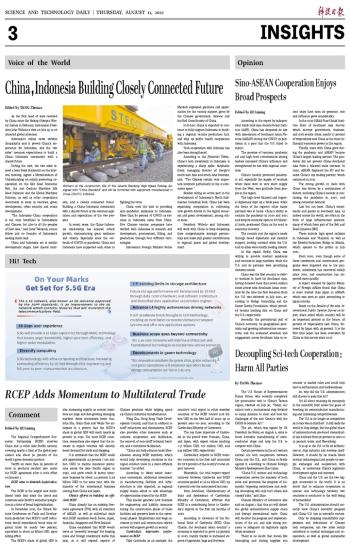
The Regional Comprehensive Economic Partnership (RCEP) involves China and 14 other Asia-Pacific nations, covering nearly a third of the global population and about 30 percent of the world's gross domestic product.
Tariffs on more than 65 percent of trade in products reached zero under the RCEP agreement after it took effect on January 1.
RCEP aims to diminish deglobalization
The RCEP is the largest new multilateral trade deal since the 1990s and continues Asia-Pacifc's economic integration in a time of broad deglobalization.
In December 2021, the United Nations Conference on Trade and Development predicted that RCEP's tariff reductions would immediately boost intra-regional trade by nearly two percent, equivalent to about 42 billion USD, upon taking effect.
The RCEP's share of global GDP is also increasing rapidly as several members are large and fast-growing emerging markets. Swiss economists Jessie Guo, John Zhu, Yaxin Chen and Weijia Yao anticipate in a project that the RCEP's share in global GDP will reach nearly 35 percent in 2030. For most RCEP countries, researchers also expect that the increase in export volumes will directly boost demand for trade and shipping.
It is estimated that the RCEP could add approximately 4.5 percent ( 720 million USD) to marine insurance premiums across the Asia-Pacific region in 2030, and grow credit & surety insurance business by about 4.4 percent (1.29 billion USD) in the same year, with the majority of the incremental business coming from China and Japan.
China's efforts in building an efficient RCEP
China already has an existing free-trade agreement (FTA) with all members of ASEAN, as well as individual deals with RCEP members South Korea, Japan, Australia, Singapore and New Zealand.
China considered that RCEP would serve as "powerful leverage" for keeping trade and foreign investment stable this year, as it will expand exports of Chinese products while helping speed up China's industrial transformation.
Wing Chu, Hong Kong Trade Development Council, said that in addition to tariff reductions and eliminations, RCEP also provides other measures such as customs cooperation and facilitation, the removal of non-tariff technical barriers, and e-commerce facilitation.
"China can help advance trade liberalization among RCEP members, which would help developing countries in the region conduct trade in a more efficient manner," he added.
According to Swiss senior insurance economists, additional investment in manufacturing facilities and infrastructure is also expected, as regional supply chains adjust to take advantage of opportunities created by the RCEP.
This should generate new business for engineering and liability insurance during the construction phase of these facilities and property lines in the operational phases. Employment and wage increases in trade and construction related sectors will support growth in society.
Cambodia's impressive performance on RCEP
Take Cambodia as an example, the country's total export to other member countries of the RCEP totaled 3.28 billion USD in the first half of 2022, up 10 percent year-on-year, according to the Cambodian Ministry of Commerce.
The top three importers of Cambodia in the period were Vietnam, China, and Japan, with export values reaching 1.17 billion USD, 612 million USD, and 542 million USD, respectively.
Cambodia's exports to RCEP member countries in the first half accounted for 28.8 percent of the country's total export turnover.
Meanwhile, the total import-export turnover between Cambodia and RCEP countries peaked at 16.24 billion USD, up 9 percent over the same period last year.
Penn Sovicheat, Undersecretary of State and Spokesman of Cambodian Ministry of Commerce, affirmed that RCEP is a contributing factor to Cambodia's exports in the first six months of 2022.
According to Governor of the National Bank of Cambodia (NBC) Chea Chanto, the Southeast Asian country’s economy is expected to grow 5.3 percent in 2022, mainly thanks to increased exports of garments, bags and footwear.


 Next
Next




